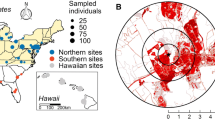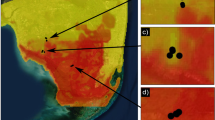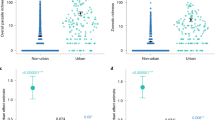Abstract
Introduced species represent a threat to native wildlife worldwide, due to predation, competition, and disease transmission. Concurrent introduction of parasites may also add a new dimension of competition, i.e. parasite-mediated competition, through spillover and spillback dynamics. Urban areas are major hotspots of introduced species, but little is known about the effects of urban habitat structure on the parasite load and diversity of introduced species. Here, we investigated such environmental effects on the ectoparasite load, richness, and occurrence of spillback in two widespread invasive parakeets, Psittacula krameri and Myiopsitta monachus, in the metropolitan area of Rome, central Italy. We tested 231 parakeets and found that in both species parasite load was positively influenced by host abundance at local scale, while environmental features such as the amount of natural or urban habitats, as well as richness of native birds, influenced parasite occurrence, load, and richness differently in the two host species. Therefore, we highlight the importance of host population density and habitat composition in shaping the role of introduced parakeets in the spread of both native and introduced parasites, recommending the monitoring of urban populations of birds and their parasites to assess and manage the potential occurrence of parasite-mediated competition dynamics as well as potential spread of vector-borne diseases.

Similar content being viewed by others
References
Ancillotto L, Serangeli MT, Russo D (2013) Curiosity killed the bat: Domestic cats as bat predators. Mammalian Biology - Zeitschrift für Säugetierkunde 78 (5):369–373
Ancillotto L, Mazza G, Menchetti M, Mori E (2014) Host specificity of the badger’s flea (Paraceras melis) and first detection on a bat host. Parasitol Res 113:3909–3912
Ancillotto L, Strubbe D, Menchetti M, Mori E (2016) An overlooked invader? Ecological niche, invasion success and range dynamics of the Alexandrine parakeet in the invaded range. Biol Invasions 18:583–595
Appelt CW, Ward LC, Bender C, Fasenella J, van Vossen BJ, Knight L (2016) Examining potential relationships between monk parakeets (Myiopsitta monachus) and avian communities in an urban environment. Wilson J Ornith 128:556–566
Aramburú R, Calvo S, Alzugaray ME, Cicchino A (2003) Ectoparasitic load of monk parakeet (Myiopsitta monachus, Psittacidae) nestlings. Ornit Neotrop 14:415–418
Baker AS (1999) Mites and ticks of domestic animals: an identification guide and information source. The Stationary Office, London
Barbar F, Lambertucci SA (2018) The roles of leporid species that have been translocated: a review of their ecosystem effects as native and exotic species. Mam Rev https://doi.org/10.1111/mam.12126
Batllori X, Nos R (1985) Presencia de la cotorrita gris (Myiopsitta monachus) y de la cotorrita de collar (Psittacula krameri) en el Area Metropolitana de Barcelona. Misc Zool 9:407–411
Bellard C, Cassey P, Blackburn TM (2016) Alien species as a driver of recent extinctions. Biol Lett 12:20150623
Blair RB (1996) Land use and avian species diversity along an urban gradient. Ecol Appl 6:506–519
Booth DT, Clayton DH, Block BA (1993) Experimental demonstration of the energetic cost of parasitism in free-ranging hosts. Proc R Soc Lond B 253:125–129
Bosso L, De Conno C, Russo D (2017) Modelling the Risk Posed by the Zebra Mussel Dreissena polymorpha: Italy as a Case Study. Environ Manag 60(2):304–313
Bowers MA, Breland B (1996) Foraging of gray squirrels on an urban-rural gradient: use of the GUD to assess anthropogenic impact. Ecol Appl 6:1135–1142
Briceño C, Surot D, González-Acuña D, Martínez FJ, Fredes F (2017) Parasitic survey on introduced monk parakeets (Myiopsitta monachus) in Santiago, Chile. Rev Bras Parasitol Vet 26:129–135
Butler CJ (2003) Population biology of the introduced Rose-ringed Parakeet Psittacula krameri in the UK. Doctoral dissertation, University of Oxford: Oxford
Capinha C, Essl F, Seebens H, Moser D, Pereira HM (2015) The dispersal of alien species redefines biogeography in the Anthropocene. Science 348:1248–1251
Chapuis JL, Obolenskaya E, Pisanu B, Lissovsky A (2011) Datasheet on Tamias sibiricus. CABI, Invasive Species Compendium, Wallingford
Cignini B, Zapparoli M (1996) Atlante degli uccelli nidificanti a Roma. Fratelli Palombi Editori, Roma
Clavero M, García-Berthou E (2005) Invasive species are a leading cause of animal extinctions. Trends Ecol Evol 20:110
Clayton DH, Drown DM (2001) Critical evaluation of five methods for quantifying chewing lice (Insecta: Phthiraptera). J Parasitol 87:1291–1300
Clemants SE, Moore G (2003) Patterns of species diversity in eight northeastern United States cities. Urban Habitats 1:4–16
Clergeau P, Vergnes A (2011) Bird feeders may sustain feral Rose-ringed parakeets Psittacula krameri in temperate Europe. Wildl Biol 17:248–252
Colautti RI, Ricciardi A, Grigorovich IA, MacIsaac HJ (2004) Is invasion success explained by the enemy release hypothesis? Ecol Lett 7:721–733
Combes C (1991) Evolution of parasite life cycles. In: Toft C, Aeschlimann A, Bolis L (eds) Parasite–host associations: coexistence or conflict? Oxford University Press, Oxford, pp 62–82
Comer JA, Paddock CD, Childs JE (2001) Urban zoonoses caused by Bartonella, Coxiella, Ehrlichia, and Rickettsia species. Vector Borne Zoonotic Dis 1:91–118
Covas L, Senar JC, Roque L, Quesada J (2017) Records of fatal attacks by rose-ringed parakeets Psittacula krameri on native avifauna. Rev Catal Ornitol 33:45–49
Cox R, Stewart PD, Macdonald DW (1999) The ectoparasites of the European badger, Meles meles, and the behavior of the host-specific flea, Paraceras melis. J Insect Behav 12:245–265
da Silva AG, Eberhard JR, Wright TF et al (2010) Genetic evidence for high propagule pressure and long-distance dispersal in monk parakeet (Myiopsitta monachus) invasive populations. Mol Ecol 19:3336–3350
Dangoisse G (2009) Étude de la population de Conures veuves (Myiopsitta monachus) de Bruxelles-Capitale. Aves 46:57–69
Delgado VCA, French K (2012) Parasite–bird interactions in urban areas: current evidence and emerging questions. Landsc Urban Plan 105:5–14
Di Santo M, Vignoli L, Battisti C, Bologna MA (2013) Feeding activity and space use of a naturalized population of monk parakeet, Myiopsitta monachus, in a Mediterranean urban area. Rev Ecol Terre Vie 68:275–282
Di Santo M, Battisti C, Bologna MA (2016) Interspecific interactions in nesting and feeding urban sites among introduced monk parakeet (Myiopsitta monachus) and syntopic bird species. Ethol Ecol Evol 29:138–148
Domènech J, Carrillo J, Senar JC (2003) Population size of the Monk Parakeet (Myiopsitta monachus) in Catalonia. Rev Cat Ornitol 20:1–9
Dunn AM, Hatcher MJ (2015) Parasites and biological invasions: parallels, interactions, and control. Trends Parasitol 31:189–199
Edelaar P, Roques S, Hobson EA (2015) Shared genetic diversity across the global invasive range of the monk parakeet suggests a common restricted geographic origin and the possibility of convergent selection. Mol Ecol 24:2164–2176
Escallón C, Becker MH, Walke JB, Jensen RV, Cormier G, Belden LK, Moore IT (2017) Testosterone levels are positively correlated with cloacal bacterial diversity and the relative abundance of Chlamydiae in breeding male rufous-collared sparrows. Funct Ecol 31:192–203
Evans MR, Goldsmith AR, Norris SR (2000) The effects of testosterone on antibody production and plumage coloration in male house sparrows (Passer domesticus). Behav Ecol Sociobiol 47:156–163
Ferman LM, Peter HU, Montalti D (2010) A study of feral pigeon Columba livia var. in urban and suburban areas in the city of Jena, Germany. Arxius de Miscellània Zoològica 8:1–8
Folstad I, Karter AJ (1992) Parasites, bright males, and the immunocompetence handicap. Am Nat 139:603–622
Forshaw JM (2010) Parrots of the world. Helm Field Guides, Christopher Helm Edtions, London
Fry DM (1995) Reproductive effects in birds exposed to pesticides and industrial chemicals. Environ Health Perspect 103:165
Gaertner M, Wilson JRU, Cadotte MW, MacIvor JS, Zenni RD, Richardson DM (2017) Non-native species in urban environments: patterns, processes, impacts and challenges. Biol Invasions 19:3461–3469
Galloway TD, Lamb RJ (2016) Chewing lice (Phthiraptera: Amblycera and Ischnocera) infesting woodpeckers and sapsuckers (Aves: Piciformes: Picidae) in Manitoba, Canada. Can Entomol 148:520–531
Golightly Jr RT, Faulhaber MR, Sallee KL, Lewis JC (1994) Food habits and management of introduced red fox in southern California. Proceedings of the Sixteenth Vertebrate Pest Conference 21
Guimarães LR (1980) Ischnocera (Mallophaga) infesting parrots (Psittaciformes). IV. Genus Echinophilopterus Ewing, 1927. Papeis avulsos de zoologia
Hernández-Brito D, Carrete M, Popa-Lisseanu AG, Ibáñez C, Tella JL (2014) Crowding in the city: losing and winning competitors of an invasive bird. PLoS One 9:e100593
Heylen DJA, Matthysen E (2008) Effect of tick parasitism on the health status of a passerine bird. Funct Ecol 22:1099–1107
Himsworth CG, Parsons KL, Jardine C, Patrick DM (2013) Rats, cities, people, and pathogens: a systematic review and narrative synthesis of literature regarding the ecology of rat-associated zoonoses in urban centers. Vector Borne Zoonotic Dis 13:349–359
Hodges JL, Le Cam L (1960) The Poisson approximation to the Poisson binomial distribution. Ann Math Stat 31:737–740
Hofer S, Gloor S, Müller U et al (2000) High prevalence of Echinococcus multilocularis in urban red foxes (Vulpes vulpes) and voles (Arvicola terrestris) in the city of Zürich, Switzerland. Parasitology 120:135–142
Hudson P, Greenman J (1998) Competition mediated by parasites: biological and theoretical progress. Trends Ecol Evol 13:387–390
Hutson AM (1984) Keds, Flat-flies and Bat-flies: Diptera, Hippoboscidae and Nycteribiidae. Royal Entomological Society of London, London
Johnson KP, Clayton DH (2003) The biology, ecology, and evolution of chewing lice, vol 24. Illinois Natural History Survey Special Publication, Champaign, pp 449–476
Jokimäki J, Suhonen J (1998) Distribution and habitat selection of wintering birds in urban environments. Landsc Urban Plan 39:253–263
Karamon J, Larska M, Jasik A, Sell B (2015) First report of the giant liver fluke (Fascioloides magna) infection in farmed fallow deer (Dama dama) in Poland–pathomorphological changes and molecular identification. Bull Vet Inst Pulawy 59:339–344
Kelly DW, Paterson RA, Townsend CR, Poulin R, Tompkins DM (2009) Parasite spillback: a neglected concept in invasion ecology? Ecology 90:2047–2056
Krasnov BR, Shenbrot GI, Khokhlova IS, Allan Degen A (2004) Relationship between host diversity and parasite diversity: flea assemblages on small mammals. J Biogeogr 31:1857–1866
Krasnov BR, Morand S, Hawlena H, Khokhlova IS, Shenbrot GI (2005) Sex-biased parasitism, seasonality and sexual size dimorphism in desert rodents. Oecologia 146:209–217
Le Louarn M, Couillens B, Deschamps-Cottin M, Clergeau P (2016) Interference competition between an invasive parakeet and native bird species at feeding sites. J Ethol 34:291–298
MacGregor-Fors I, Calderón-Parra R, Meléndez-Herrada A, López-López S, Schondube JE (2011) Pretty, but dangerous! Records of non-native monk parakeets (Myiopsitta monachus) in Mexico. Rev Mex Biodiversidad 82:1053–1056
Mack RN, Simberloff D, Mark Lonsdale W, Evans H, Clout M, Bazzaz FA (2000) Biotic invasions: causes, epidemiology, global consequences, and control. Ecol Appl 10:689–710
Marsot M, Chapuis JL, Gasqui P, Dozières A, Massèglia S, Pisanu B, Ferquel B, Vourc’h G (2013) Introduced Siberian chipmunk (Tamias sibiricus barberi) contribute more to Lyme borreliosis risk than native reservoir rodents. PLoS One 8:e55377
Mazza G, Tricarico E, Genovesi P, Gherardi F (2014) Biological invaders are threats to human health: an overview. Ethol Ecol Evol 26:112–129
Mazzamuto MV, Pisanu B, Romeo C et al (2016) Poor parasite Community of an invasive alien Species: macroparasites of Pallas’s squirrel in Italy. Ann Zool Fenn 53:103–112
McKinney ML (2008) Effects of urbanization on species richness: a review of plants and animals. Urban Ecosyst 11:161–176
Menchetti M, Mori E (2014) Worldwide impact of alien parrots (Aves Psittaciformes) on native biodiversity and environment: a review. Ethol Ecol Evol 26:172–194
Møller AP, Dufva R, Allander K (1993) Parasites and the evolution of host social behavior. Adv Study Behav 22:60405–60402
Mori E, Di Febbraro M, Foresta M, Melis P, Romanazzi E, Notari A, Boggiano F (2013) Assessment of the current distribution of free-living parrots and parakeets (Aves: Psittaciformes) in Italy: a synthesis of published data and new records. Ital J Zool 80:158–167
Mori E, Ancillotto L, Groombridge J, Howard T, Smith VS, Menchetti M (2015) Macroparasites of introduced parakeets in Italy: a possible role for parasite-mediated competition. Parasitol Res 114:3277–3281
Mori E, Ancillotto L, Menchetti M, Strubbe D (2017) “The early bird catches the nest”: possible competition between scops owls and ring-necked parakeets. Anim Conserv 20:463–470
Mori E, Zozzoli R, Menchetti M (2018) The invasion of “Chip ‘n Dale”: global distribution and status of introduced Siberian chipmunks Eutamias sibiricus. Mammal Rev. https://doi.org/10.1111/mam.12117
Onstad DW, McManus ML (1996) Risks of host range expansion by parasites of insects. BioScience 46:430–435
Orchan Y, Chiron F, Shwartz A, Kark S (2013) The complex interaction network among multiple invasive bird species in a cavity-nesting community. Biol Invasions 15:429–445
Orton DI, Warren LJ, Wilkinson JD (2000) Avian mite dermatitis. Clin Exp Dermatol 25:129–131
Owen JP, Delany ME, Cardona CJ, Bickford AA, Mullens BA (2009) Host inflammatory response governs fitness in an avian ectoparasite, the northern fowl mite (Ornithonyssus sylviarum). Int J Parasitol 39:789–799
Palma RL (1978) Slide-mounting of lice: a detailed description of the Canada balsam technique. N Z Entomol 6:432–436
Pârâu LG, Strubbe D, Mori E et al (2016) Rose-ringed Parakeet Psittacula krameri populations and numbers in Europe: a complete overview. Open Ornithol J 9(1):1–13
Parsons H, Major RE, French K (2006) Species interactions and habitat associations of birds inhabiting urban areas of Sydney, Australia. Austral Ecol 31:217–227
Pinheiro J, Bates D, DebRoy S, Sarkar D (2014) nlme: linear and nonlinear mixed effects models. R package version 3.1–117. Available at http://CRAN.R-project.org/package=nlme
Pisanu B, Laroucau K, Aaziz R et al (2018) Chlamydia avium detection from a Ring-necked parakeet (Psittacula krameri) in France. J Exot Pet Med. https://doi.org/10.1053/j.jepm.2018.02.035
Poulin R (1996) Sexual inequalities in helminth infections: a cost of being a male? Am Nat 147:287–295
Price RD, Hellenthal RA, Palma RL (2003) World checklist of chewing lice with host associations and keys to families and genera. In: Price RD, Hellenthal RA, Palma RL, Johnson KP, Clayton DH (eds) The chewing lice: world checklist and biological overview. Illinois Natural History Survey Special Publication, Champaign-Urbana, pp 1–448
Pyke GH, Szabo JK (2018) Conservation and the 4 Rs, which are rescue, rehabilitation, release, and research. Conserv Biol 32:50–59
R Core Team (2016) R: A language and environment for statistical computing. R Foundation for Statistical Computing, Wien
Ralph CJ, Sauer JR, Droege S (1995) Monitoring bird populations by point counts. Gen. Tech. Rep. PSW-GTR-149. Department of Agriculture, Forest Service, Pacific Southwest Research Station, Albany
Roberts ML, Buchanan KL, Evans MR (2004) Testing the immunocompetence handicap hypothesis: a review of the evidence. Anim Behav 68:227–239
Romeo C, Wauters LA, Ferrari N, Lanfranchi P, Martinoli A, Pisanu B, Preatoni DG, Saino N, Russo D (2014) Macroparasite fauna of alien grey squirrels (Sciurus carolinensis): composition, variability and implications for native species. Plos One 9(2) e88002
Rothenburger JL, Himsworth CH, Nemeth NM, Pearl DL, Jardine CM (2017) Environmental factors and zoonotic pathogen ecology in urban exploiter species. EcoHealth 14:630–641
Sakai AK, Allendorf FW, Holt JS, Lodge DM, Molofsky J, With KA, Baughman S, Cabin RJ, Cohen JE et al (2001) The population biology of invasive species. Annu Rev Ecol Syst 32:305–332
Shochat E, Lerman SB, Anderies JM, Warren PS, Faeth SH, Nilon CH (2010) Invasion, competition, and biodiversity loss in urban ecosystems. BioScience 60:199–208
Smit FGAM (1983) Key to the genera and subgenera of Ceratophyllidae. In: Traub R, Rothschild M, Haddow J (eds) The Rothschild collection of fleas. The Ceratophyllidae. British Museum (Nat. Hist.), London, pp 1–36
Strubbe D, Matthysen E (2011) A radiotelemetry study of habitat use by the exotic Ring-necked Parakeet Psittacula krameri in Belgium. Ibis 153:180–184
Torchin ME, Mitchell CE (2004) Parasites, pathogens, and invasions by plants and animals. Front Ecol Environ 2:183–190
Turbè A, Strubbe D, Mori E et al (2017) Assessing the assessments: evaluation of four impact assessment protocols for invasive alien species. Divers Distrib 23:297–307
Tuttle LJ, Sikkel PC, Cure K, Hixon MA (2017) Parasite-mediated enemy release and low biotic resistance may facilitate invasion of Atlantic coral reefs by Pacific red lionfish (Pterois volitans). Biol Invasions 19:563–575
Uller T, Olsson M (2003) Prenatal exposure to testosterone increases ectoparasite susceptibility in the common lizard (Lacerta vivipara). Proc R Soc Lond B Biol Sci 270:1867–1870
van Rensburg BJ, Peacock DS, Robertson MP (2009) Biotic homogenization and alien bird species along an urban gradient in South Africa. Landsc Urban Plan 92:233–241
Vila’ M, Maron JL, Marco L (2005) Evidence for the enemy release hypothesis in Hypericum perforatum. Oecologia 142:474–479
Vourc’h G, Abrial D, Bord S, Jacquot M, Masseglia S, Poux V, Pisanu B, Bailly X, Chapuis JL (2016) Mapping human risk of infection with Borrelia burgdorferi sensu lato, the agent of Lyme borreliosis, in a periurban forests in France. Ticks Tick Borne Dis 5:644–652
Welch JN, Leppanen C (2017) The threat of invasive species to bats: a review. Mammal Rev 47(4):277–290
Whitaker AP (2007) Fleas (Siphonaptera). In: Royal Entomological Society, Spencer KA (eds) Handbook for the identification of British insects. Entomological Society of London, London
Acknowledgements
We thank all the people and volunteers from Lipu Wildlife Rescue Centre in Rome for their kind help in collecting data. Two reviewers made valuable comments on a previous ms version.
Funding
Two authors (LA and EM) were funded by two Short Term Scientific Missions by the COST Action ES1304 “Parrotnet - European Network on Invasive Parakeets”.
Author information
Authors and Affiliations
Corresponding author
Ethics declarations
All applicable international, national, and/or institutional guidelines for the care and use of animals were followed.
Conflict of interest
The authors declare that they have no conflict of interest.
Additional information
Section Editor: Boris R. Krasnov
Rights and permissions
About this article
Cite this article
Ancillotto, L., Studer, V., Howard, T. et al. Environmental drivers of parasite load and species richness in introduced parakeets in an urban landscape. Parasitol Res 117, 3591–3599 (2018). https://doi.org/10.1007/s00436-018-6058-5
Received:
Accepted:
Published:
Issue Date:
DOI: https://doi.org/10.1007/s00436-018-6058-5




